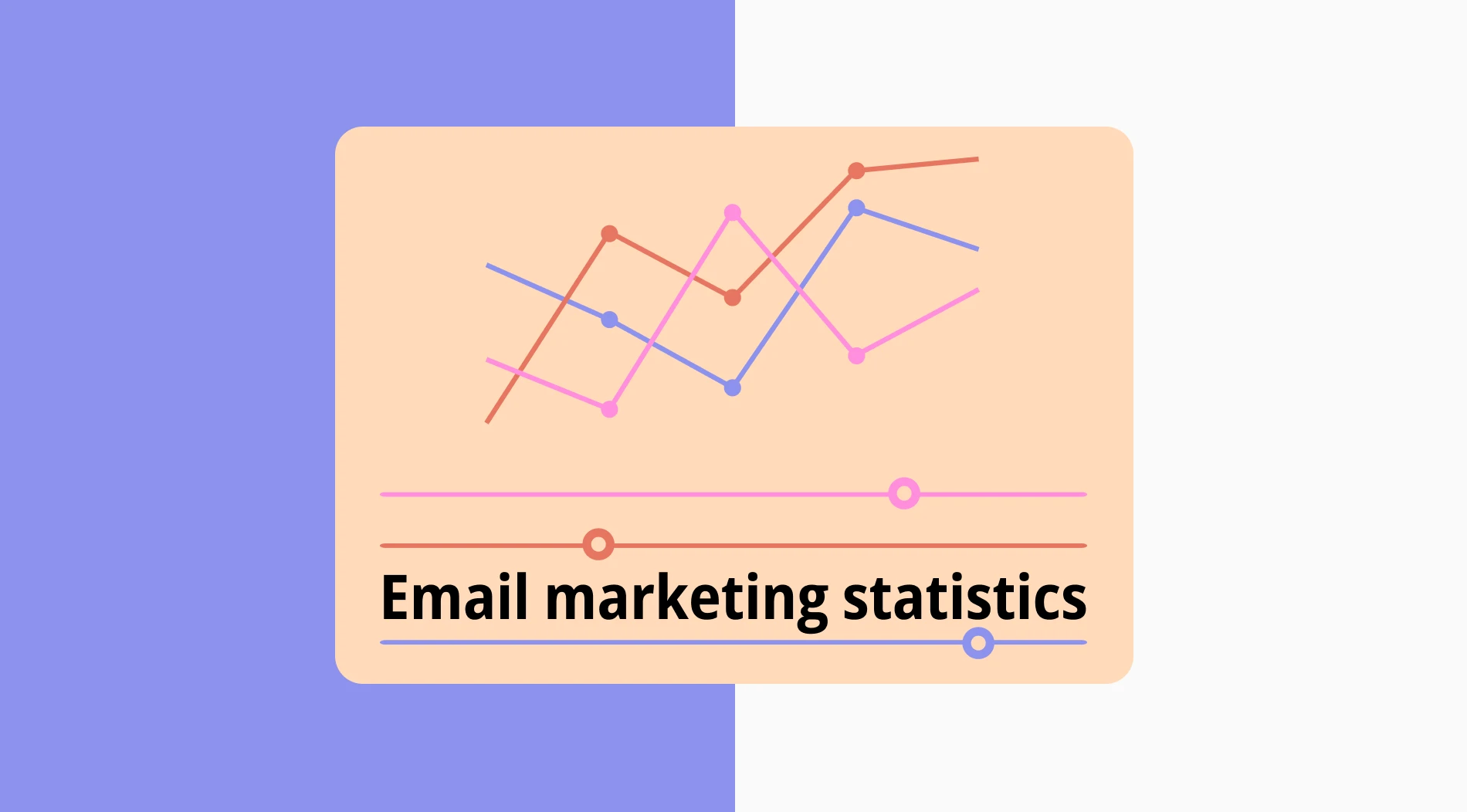Do you wonder about the impact of email marketing on the marketing world? If you do, you will have no questions mark at the end of the article. Email marketing is not a recent trendy method applied by marketers. It has been done for years, yet it has not lost popularity.
Email marketing is an important part of digital marketing. As long as they are used effectively, it is impossible to ignore its advantages. In our article, we aim to prove to you the impact and effectiveness of email marketing by sharing 100+ excellent statistics about it. If you want to learn the detailed data, start reading now!
Highlights about email marketing
Even though it has existed for more than four decades, email marketing has not seemed to lose its popularity among marketers. However, if you do not know exactly what it is or want to know some interesting facts about it, here are some highlights about email marketing:
- Email marketing began in 1978.
- Gary Thuerk is known as the father of spam.
- The most common email password is 123456.
- Emails sent on Monday generate the most revenue for each email.
- A person’s daily email inbox contains just 14% of important emails.
100+ Best email marketing statistics to get valuable insights
The best and most professional way of approaching an issue is to check the statistics. By checking the statistics given above, you can make healthier decisions without taking fewer risks and spending less money. Check out these 100+ best email marketing statistics to get valuable insights:
General email marketing statistics
General email marketing statistics should be the first category if you want to have a general idea about the issue. You can collect reliable information and make better inferences by looking at them. If you need general email marketing statistics, have a look at these:
1. 78% of marketers said they use email to offer customized content to their subscribers to please consumers and produce more permanent communications. (Statista)
2. According to research by Experian, email subject lines incorporating an emoji raised open rates over text-only subject lines by 56%. (Campaign Monitor)
3. Compared to Facebook and X put together, email is 40 times more successful in acquiring clients. (Entrepreneur)
4. When consumers are advertised via email, they spend 138% more than when they are not. (Disruptive)
5. Compared to other sing-offs, an email that concludes with “thanks in advance” or similar expressions got more responses. (Boomerang)
6. Compared to visitors from social media and search engines, email subscribers are 3.9 times more likely to promote your content on social media, and 4.24% of email marketing visitors make purchases. (webinarcare)
7. Companies who are excellent with marketing automation intend to raise their budgets by 63%. (emailmonday)
8. Outside of the workplace, a study discovered that Americans frequently check their email while watching TV (70%), from bed (52%), on holiday (50%), from the mobile (43%), from the bathroom (42%), and even while driving (18%). (Adobe)
9. Time spent on checking email climbed by 17%. (Toner Buzz)
10. 5 to 10 p.m. views 66% of unsubscribers. (Tomasz Tunguz)
11. Compared to broadcast emails, relevant and personalized emails generate 18x more income. (TechTarget)
12. We check our emails 150 times a day. (The Hindu Business Line)
13. More than 32 characters in the subject line will be cut on iPhones. (Manychat)
14. Your email campaigns’ click rates might increase by 300% by using video. (Poll the People)
15. Compared to non-nurtured leads, nurtured emails produce 47% better transactions. (AnnuItas)
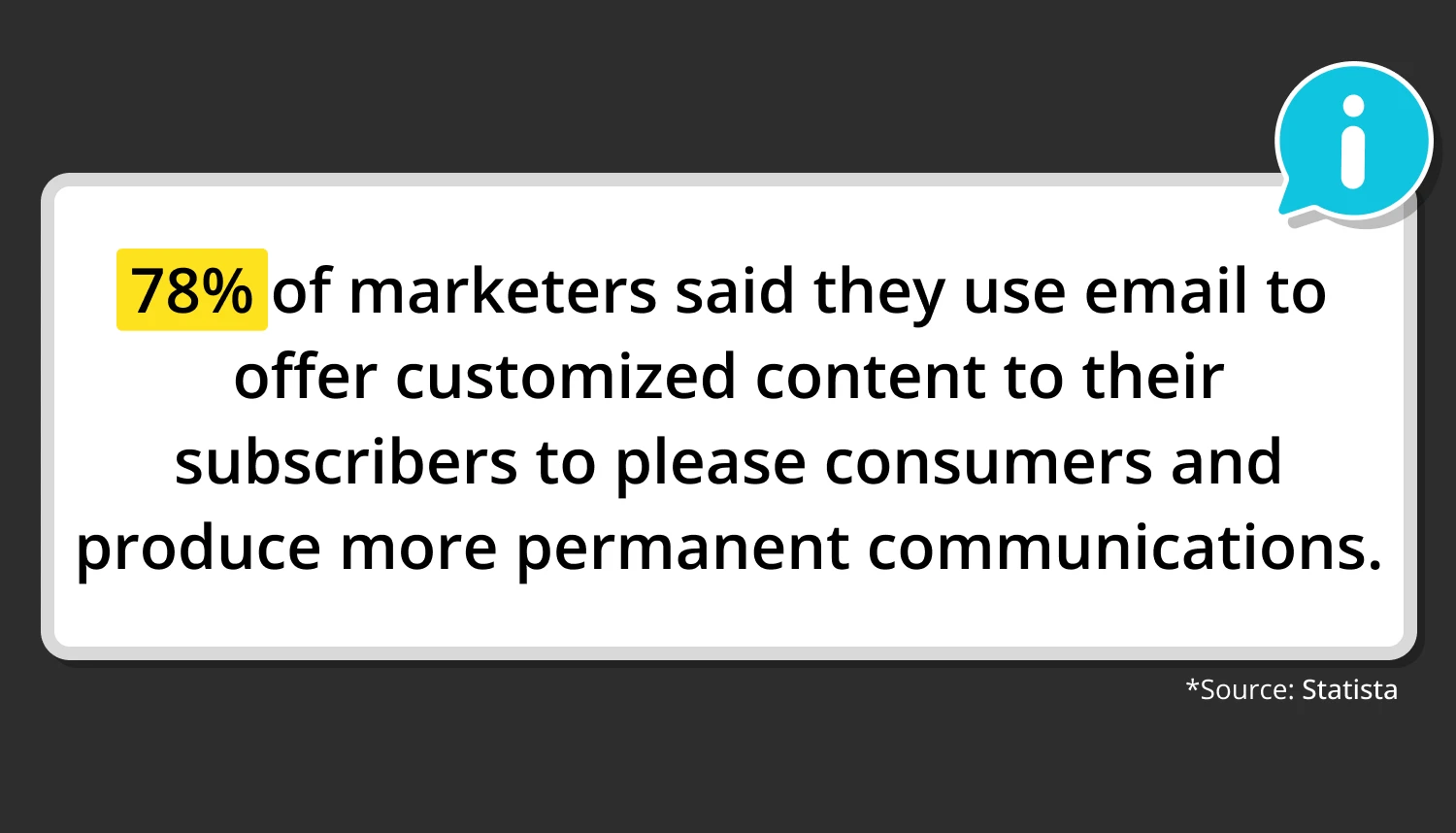
Source: Statista
Email open rate statistics
Sending random emails is not a good email marketing strategy, needless to say. Open rates have a huge impact on success. There are some practices behind increasing the open rate, such as paying attention to the engagement rate or creating better email content for email recipients. Check these email open rate statistics:
16. The open rate for personalized emails was 13.1% higher when compared to not personalized ones in 2016. (Statista)
17. Between 2015 and 2018, the average open rate globally remained at 24%. (SuperOffice)
18. The open rate for all industries in 2021 was 21.3%. (SuperOffice)
19. In 2022, the average open rate decreased to 16.97%, with a 10.29% CTR. (Smart Insights)
20. Only 7.10% open an email because of the intro paragraph. (SuperOffice)
21. Since 2011, the mobile email open rate has increased by more than 100%. (SuperOffice)
22. 3% of email opens happen during the first hour of delivery. (SuperOffice)
23. The optimal day and hour for sending an email is on a Tuesday after 1 p.m. (SuperOffice)
24. While 45.90% open an email because of the sender’s name, 13.10% read the mail for the sake of an offer. (SuperOffice)
25. With the 24 percent, Germany has the highest click-through rate (CTR). (SuperOffice)
💡Tip: Click-through rate (CTR) refers to the percentage of website visitors who click to follow a link to another website.
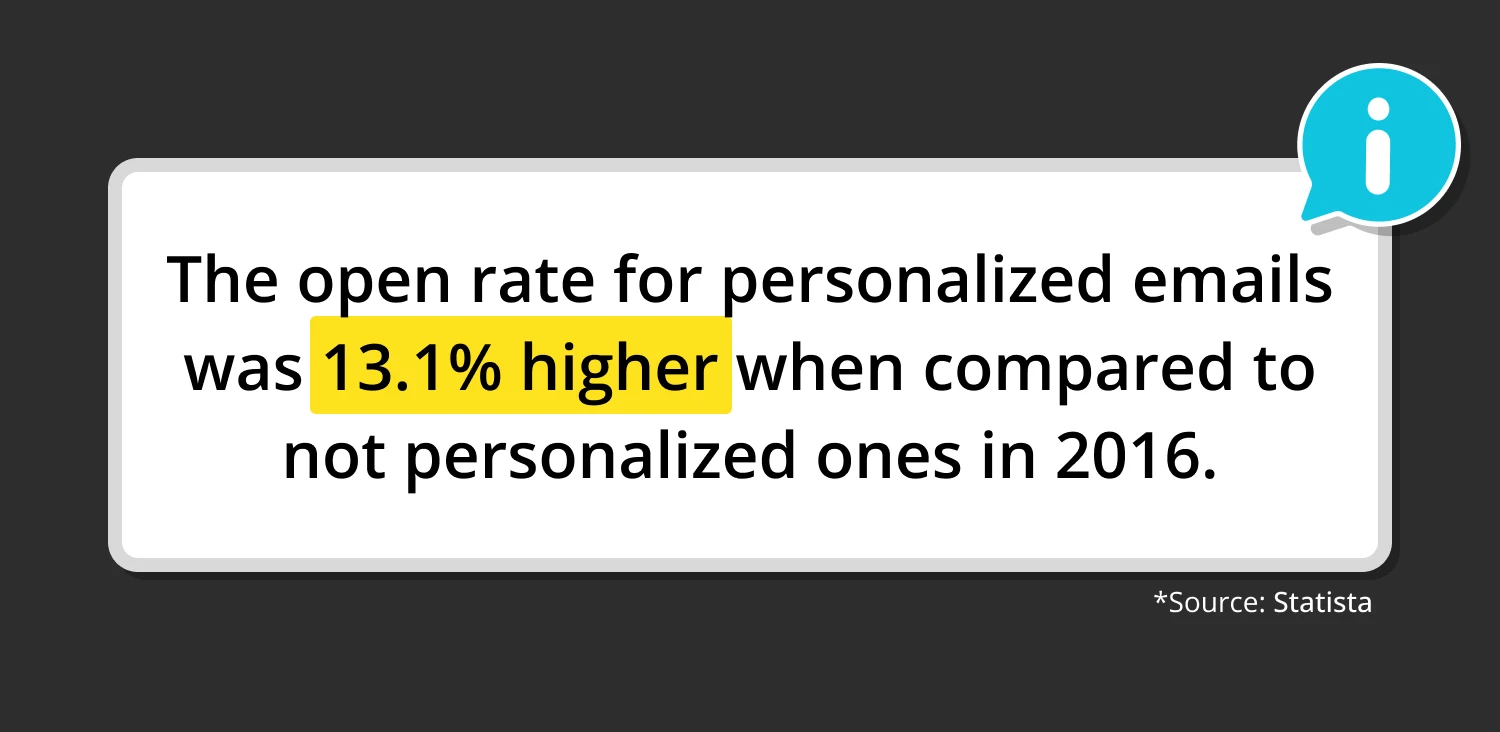
Source: Statista
B2B email marketing statistics
When it comes to B2B marketing, you need to apply a different point of view for your email marketing strategy, needless to say. Businesses spend lots of money on billions of emails and try to get better in constant contact. To see interesting email marketing benchmarks related to B2B marketing, check these statistics:
26. In 2025, there will be about 4.6 billion email users. (Statista)
27. In 2020, approximately 306 billion email was sent and received globally. (Statista)
28. In the next two years, the number of daily sent and received emails is expected to be 376 billion.
29. 56 percent of B2B businesses have specialized marketing staff. (Statista)
30. Only 5% of US B2B businesses devote their budgets to marketing. (Statista)
31. B2B companies spend 13% more on digital marketing than on traditional marketing. (Statista)
32. 75% of B2B companies employ email marketing software to assist with content marketing. (Content Marketing Institue)
33. 69% of B2B businesses utilize email newsletters. (Content Marketing Institue)
34. 82% of the B2B clients are comfortable using brand purchasing history. (Statista)
35. For 64% of B2B companies, email engagement rates are seen as the most valuable statistic. (Content Marketing Institue)
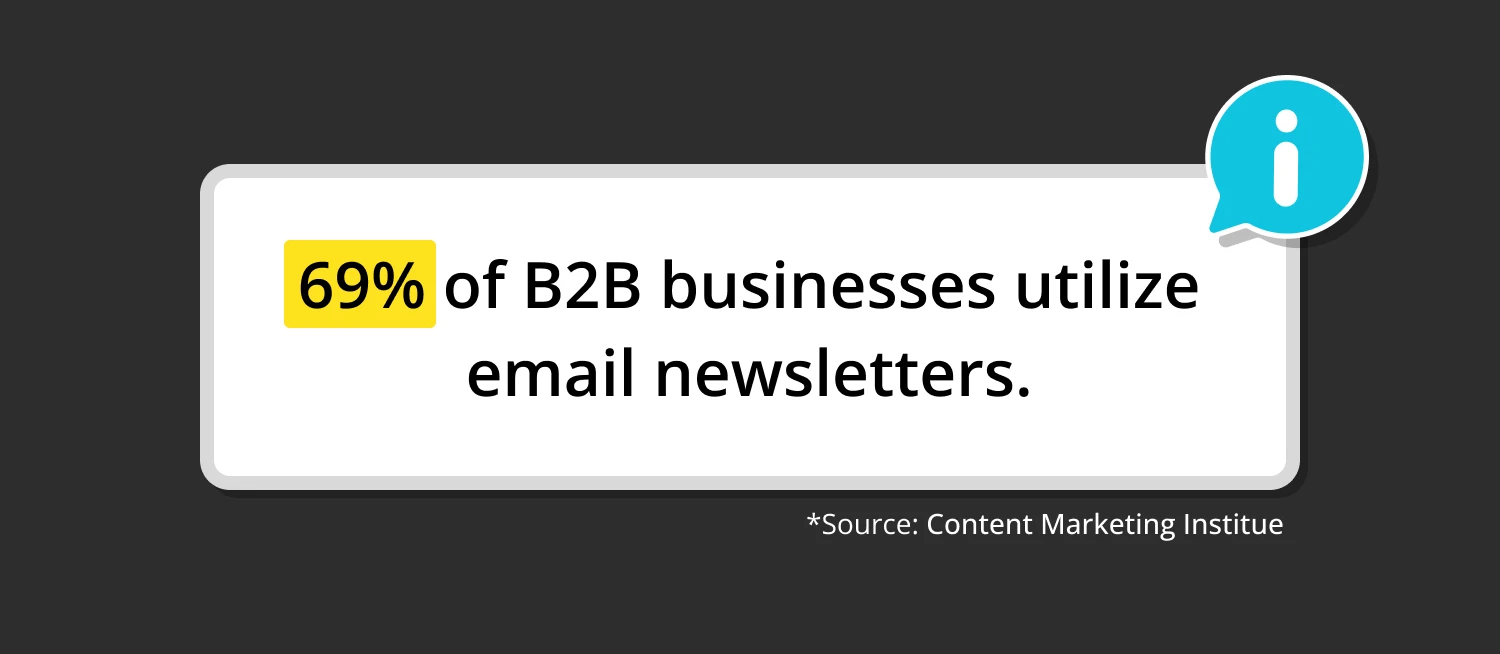
Source: Content Marketing Institue
B2C email marketing statistics
As in many areas, email marketing has a strong impact on B2C. Generally, B2C companies aim to attract customers via email marketing campaigns or personalized subject lines. However, each of them has characteristic strategies. If you are wondering about B2C email marketing statistics, here are them:
36. As a part of their email marketing strategy, 87% of B2C marketers use automation. (HubSpot)
37. 15.8% of emails are lost or blocked by spam filters. (EmailToolTester)
38. 80 percent of business leaders think email marketing improves client retention.
39. Emails sent by 52% of B2C companies are not mobile-friendly. (HubSpot)
40. The % of consumers who check their email in the morning is 58%. (Porch Group Media)
41. 59% of customers claim email marketing affects their purchasing process. (OptinMonster)
42. In order to have a customized service, 83% of customers do not mind providing data. (Accenture)
43. 17% of B2C marketers contact their clients only once a month. (SaleCycle)
44. 8 out of 10 recipients will open a welcome email. (Get Response)
45. The open rate for the single message autoresponder email was 98%, whereas the click-through rate was 37%. (Get Response)

Source: HubSpot
Mobile email marketing statistics
Today, mobile phones have become an important part of our lives, not just marketing. Lots of people check their emails on their mobile phones. For that reason, mobiles have an important place in the email marketing world. To show the importance of mobiles in email marketing, here are mobile email marketing statistics:
46. While 81% of people check emails on their mobiles, 21% of people check emails on tablets. (Campaign Monitor)
47. In 2018, Apple remained the most widely used mobile customer reading emails, making up 29% of all openings, an increase of 1% compared to 2017. (Campaign Monitor)
48. Google was the second in the top 10 email clients in 2018. (Campaign Monitor)
49. The most popular email platform is Apple’s. (Zapier)
50. Mobile devices make up one out of every three email clicks. (campaing monitor)
51. Up to 30 characters of the subject line of an email are shown on mobile devices. (truelist)
52. Visitors are more likely to visit your website by 65% after reading on a mobile. (Porch Group Media)
53. More than 33% of business professionals say that they check their emails on mobile devices. (weMail)
54. Mobiles are used to open 36.3% of emails globally. (Increditools)
55. 85% of customers access email via their mobile phones. (99 Firms)
💡Tip: 85% of customers access email via mobile phones, so you should prepare your emails mobile-optimized!
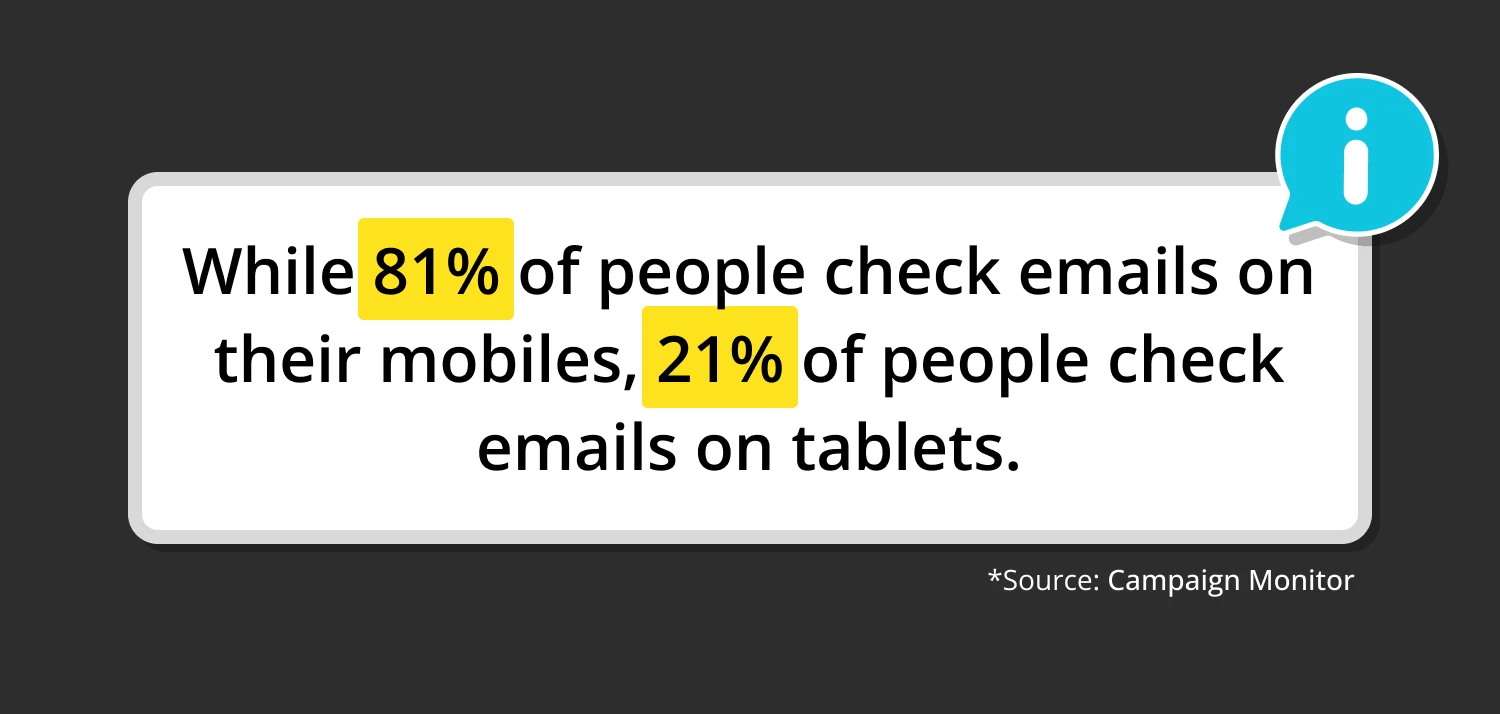
Source: Campaing Monitor
Email marketing ROI statistics
Email marketing spends a lot of budget for businesses. Nevertheless, you do not have to raise too much money because you have excellent statistics that we share with you! If you do not want to spend money on useless email addresses with weak content, have a look at these email marketing ROI statistics:
💡Tip:ROI stands for “return on investment.” It justifies your marketing budget for current and future campaigns.
56. Marketers generate $42 for every $1 spent on email marketing. (litmus)
57. People choose email as a brand’s primary method of contact 72% of the time. (Almond Branch Marketing)
58. Customers say that 36% use email as their main method of learning about corporate shifts. (Insider Intelligence)
59. 77% of marketers claimed that their email engagement rate has increased. (HubSpot)
60. 60% of customers made a purchase as a result of receiving marketing emails. (Constant Contact)
61. 91% of American adults desire to get more promotional emails often. (PR Newswire)
62. The typical email CTR was above 15%; in 2022, it was 16.79%. (Barillance)
63. Just 25% of businesses believe their tracking of email ROI is appropriate. (mailmodo)
64. 59% of consumers claim email marketing influences shopping decisions. (Luisa Zhaou)
65. To reach clients, 64% of small businesses choose email marketing. (HubSpot)
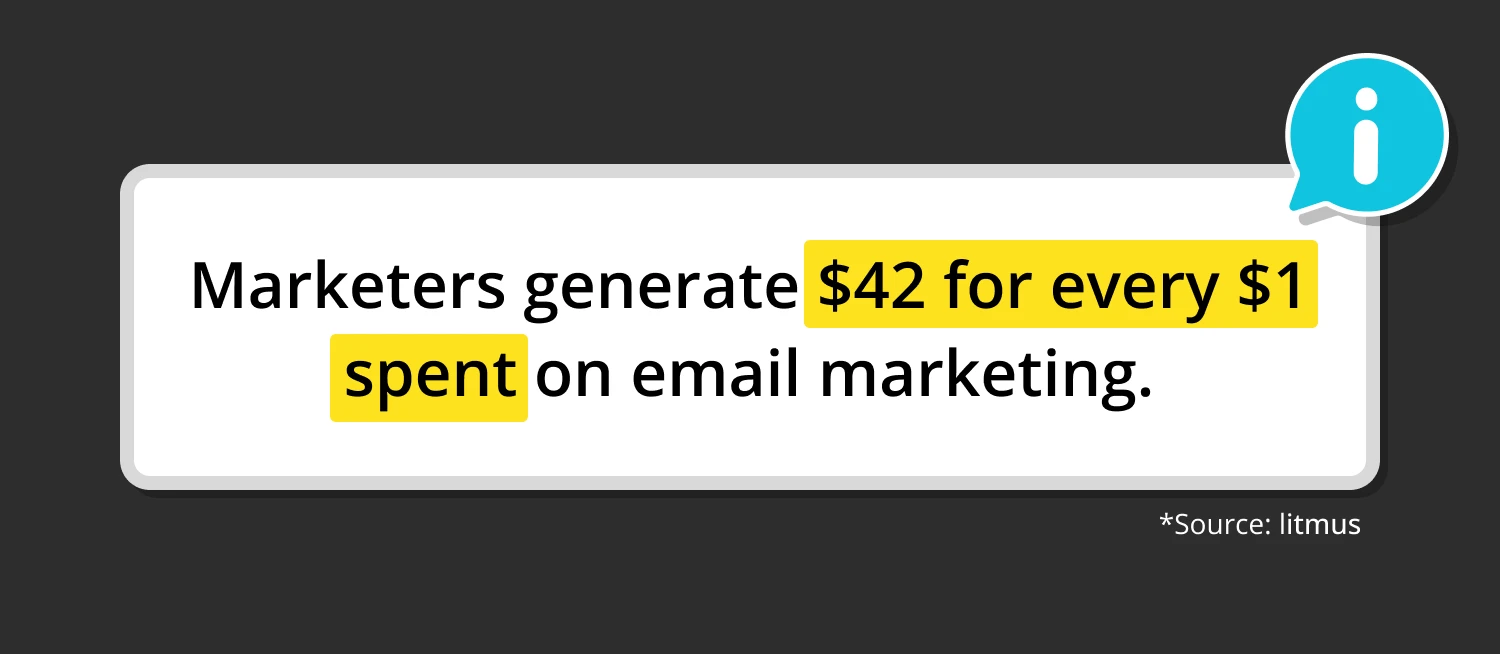
Source: litmus
Email marketing statistics by industry
Each industry has its own style of email marketing. It would be incorrect to try to rule all the industries with the same email marketing pattern. If you want to understand the difference between different industries, you need to have a look at these email marketing statistics by industry:
💡Tip: Open rate = (total unique opens / total recipients) x 100
CTR rate= clicks/impressions
66. With a CTR of 28.5%, the education sector has the highest open and click-through rates. (Campaign Monitor)
67. Retail holds the record for both the smallest open rate by industry (17.1%) and the largest increase in open rate over a year (up 4.5%). (Campaign Monitor)
68. With 17.2%, Real estate, Design, and construction is the industry with the highest click-through rate in 2021. (Campaign Monitor)
69. Wellness & Fitness has the highest unsubscribe rate (0.4%). (Campaign Monitor)
70. With the 0.7 rate, Retail has the lowest CTR.
71. Government-related emails had the highest rate, with a 28.77% average. (Mailchimp)
72. A healthy email click-through rate should be between 2 and 5 percent. (Campaign Monitor)
73. With a 27.74% open rate, emails sent by hobby-related businesses came in second. (Mailchimp)
74. Emails related to religion came in third with a 27.62% open rate. (Mailchimp)
75. Vitamin supplements have the lowest average open rate, with 15.03%. (Mailchimp)
76. For all the industries that Mailchimp found, the average open rate is 21.33%. (Mailchimp)
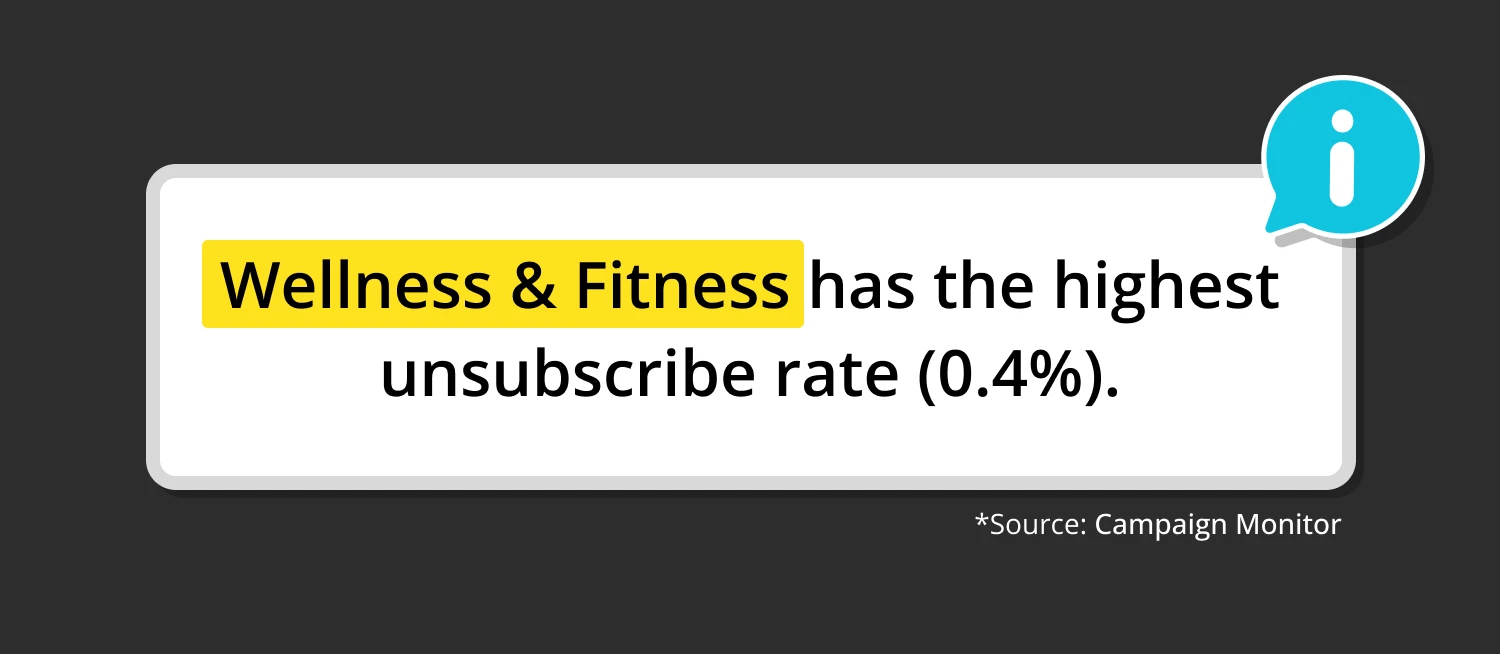
Source: Campaign Monitor
Statistics on AI in email marketing
When you put AI and email marketing together, they create perfection. Since AI has become a major tool in technology, email marketing takes advantage of it, too. However, if you have no idea about the relationship between AI and email marketing, here are some interesting statistics on AI in email marketing:
77. People are unfamiliar with AI in email marketing in 33.7% of cases. (Selzy)
78. Only 28% of users have knowledge about AI’s developing powers. (Selzy)
79. 63% of consumers believe in AI email-generating innovations; however, they should still double-check their mail. (Selzy)
80. 24.7% completely rely on emails created by AI. (Selzy)
81. 12.3% have a skepticism about trust in emails created by AI. (Selzy)
82. 38.5% of users consider AI-driven email analytics safe to utilize. (Selzy)
83. 14.1% of users say that theft has concerns about AI mail. (Selzy)
84. Interestingly, 42.3% have never heard of AI in relation to email analytics. (Selzy)
85. 87.7% of Selzy users completely trust emails generated by AI. (Selzy)
86. 50.7% of users believe AI to be more successful in email marketing than traditional email marketing methods. (Selzy)
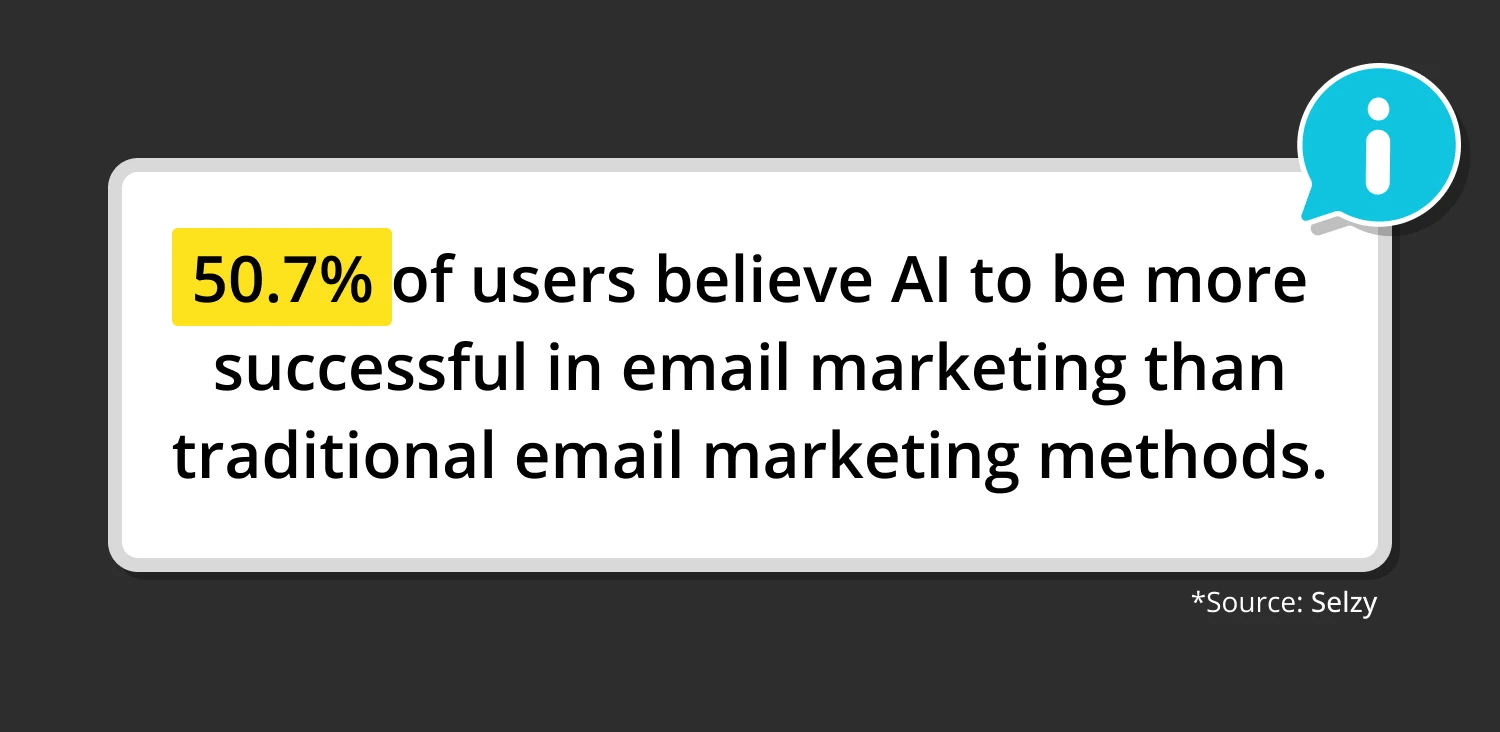
Source: Selzy
Email personalization statistics
Personalized emails show you value each of your customers. Instead of speaking or calling your respondents generally, creating more personalized lines or content will attract them more. If you need some proof of the power of email personalization, you can have a look at the email marketing stats given below:
87. Marketers claim personalized advertising has increased email revenue by 760%. (Campaign Monitor)
88. According to 55% of users, specific discounts or promotions would make emailing more enjoyable. (Dynamic Yield)
89. Personalized calls to action convert 202% better than standard calls to action. (HubSpot)
90. Emails coming from entertainment industries with personalized subject lines had two times more open rates. (Netcore)
91. Personalization lowers the open rates in the BFSI sectors, such as the banking and insurance sectors. However, in the other sector, personalization definitely increases the open rate. (Netcore)
92. Compared to 80% of financial services organizations, 60% of retail, e-commerce, and customer service and goods businesses customize email body copy. (litmus)
93. Personalized email subjects increase the open rate by 50%. (litmus)
94. If the email is not personalized, 52% of customers say they would look elsewhere to discover what they are searching for. (Instapage)
95. 74% of people hate receiving irrelevant content. (Optin Monster)
96. The customer’s name is the most frequently used in the email subject line (46.21%) (Snov.io)

Source: litmus
Statistics about email marketing demographics
People might have different habits when using email, which seriously affects email marketing methods and strategies. For that reason, it is the key point to check demographics related to email marketing. You can quickly check the statistics about email marketing demographics:
97. According to a study, 99% of us check emails daily (Optin Monster)
98. The first thing to do in the morning of 58% is to check their emails. (Optin Monster)
99. 84.3% of customers report they check emails at least once daily. (Yaguara)
100. 67% of Gen Z check their emails on mobile. (Bluecore)
101. After 72% of Gen X, 64% of Millenials, and 60% of Gen Z, 74% of Baby Boomers believe email to be the most personal channel for businesses to communicate with customers. (Bluecore).
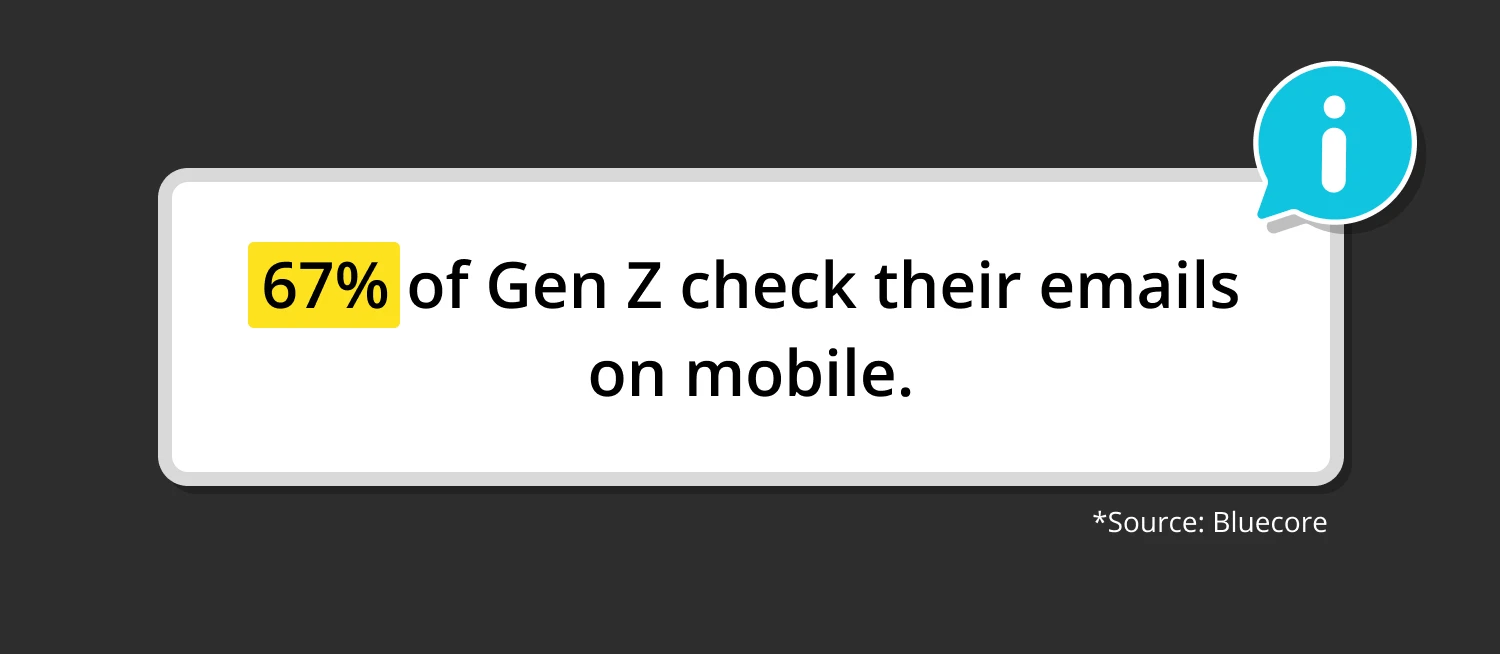
Source: Bluecore
Email frequency statistics
Email frequency statistics can give you lots of useful tips for your businesses on the frequency of sending emails. This frequency might differ depending on your industry or business. However, looking at the email frequency statistics given below can show you how big email marketing is:
102. In 2019, 293.6 billion emails were sent on a daily basis. (Templafy)
103. In 2020, the overall amount of emails sent grew by 7%. (Campaign Monitor)
104. It was anticipated that in 2021, there would be more than 319 billion daily emails sent and received by consumers and businesses combined. (Radicati Group)
105. The study shows that 3.4 billion fake emails are sent. (Valimail)
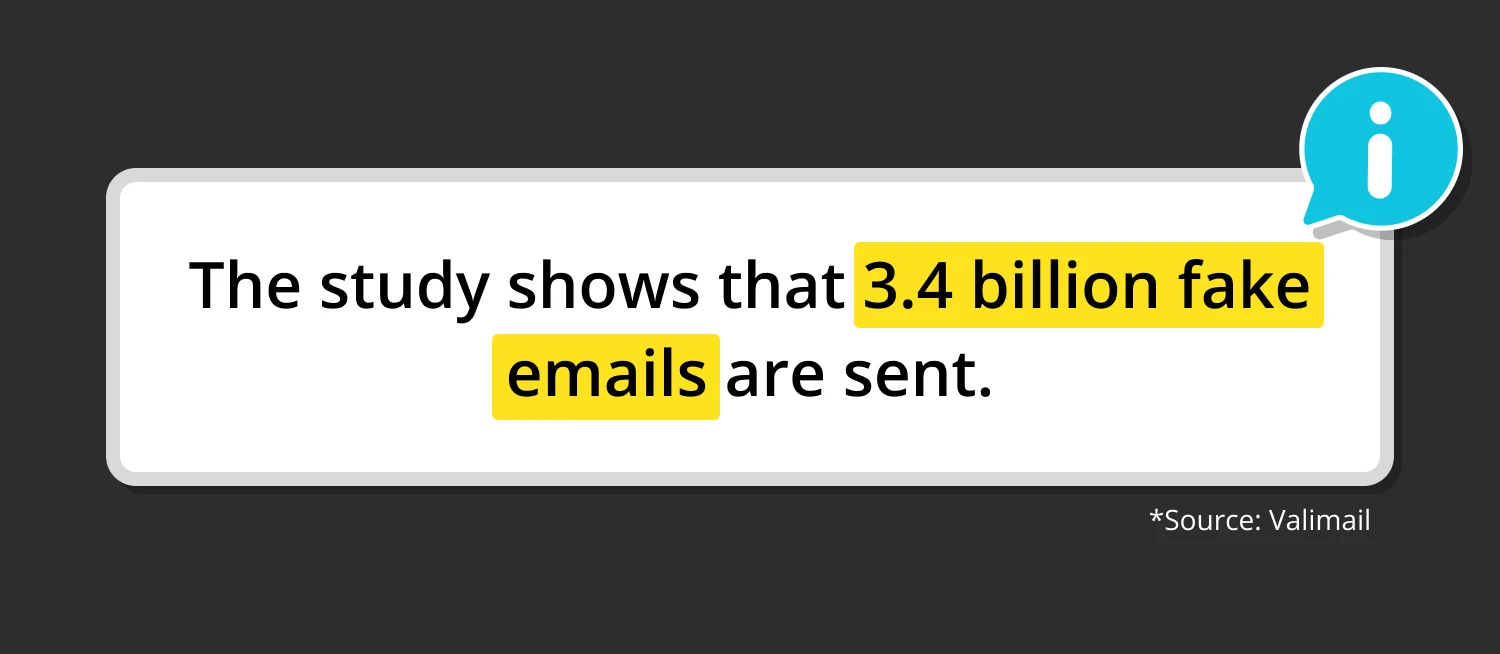
Source: Valimail
Frequently asked questions about email marketing
Even though you know lots of useful information about email marketing, you might still be wondering about some specific points about email marketing. Look at these five frequently asked questions about email marketing given below might help you:
1. What is Email Marketing?
Email marketing can be defined as a kind of marketing strategy for sending commercial or advertisement messages via email. This way, businesses or companies can easily promote their services or products.
2. What is B2B email marketing?
B2B email marketing is a kind of email marketing that targets companies rather than individual customers themselves. Through the emails businesses send, they can communicate with sales prospects and inform them of their offerings
3. Is email marketing dead?
The answer to this question is simply no. As you read, 99% of people still check their email daily. So, can you imagine the power of email? As long as you know how to use email marketing effectively, you can increase your company's sales and success rate.
4. How often should I email people?
Speaking of generals, sending emails two or three times every week would be better for your company. However, while doing that, you need to take into consideration the active hours of your users for higher open rates.
5. How can I personalize emails?
In the first place, you might consider learning the user’s specific info, such as gender and location. Also, you can think about browsing your user or subscriber’s browsing data. Do not forget that celebrating important anniversaries or birthdays personalizes your email more and creates a good bond between your business and users.
Key points to take away
In a nutshell, email marketing is still a strong marketing strategy used by marketers and increases the success of companies. In this article, we collected 100+ eye-opening email marketing statistics so that you get a good idea of its power. With all these useful and insightful data, you can take action now and benefit from the privileges of email marketing!
Şeyma is a content writer at forms.app. She loves art and traveling. She is passionate about reading and writing. Şeyma has expertise in surveys, survey questions, giveaways, statistics, and online forms.
